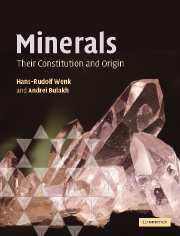Book contents
- Frontmatter
- Contents
- Preface
- Acknowledgments
- Figure credits
- Part I Structural features of minerals
- Part II Physical investigation of minerals
- Part III Variety of minerals and mineral-forming processes
- Part IV A systematic look at mineral groups
- 19 Important information about silica materials and feldspars
- 20 Simple compounds. Unusual mineral occurrences
- 21 Halides. Evaporite deposits
- 22 Carbonates and other minerals with triangular anion groups. Sedimentary origins
- 23 Phosphates, sulfates, and related minerals. Apatite as a biogenic mineral
- 24 Sulfides and related minerals. Hydrothermal processes
- 25 Oxides and hydroxides. Review of ionic crystals
- 26 Orthosilicates and ring silicates. Metamorphic mineral assemblages
- 27 Sheet silicates. Weathering of silicate rocks
- 28 Chain silicates. Discussion of some igneous and metamorphic processes
- 29 Framework silicates. Zeolites and ion exchange properties of minerals
- Part V Applied mineralogy
- Appendices
- Glossary
- References
- Index
- Plate section
- References
24 - Sulfides and related minerals. Hydrothermal processes
from Part IV - A systematic look at mineral groups
- Frontmatter
- Contents
- Preface
- Acknowledgments
- Figure credits
- Part I Structural features of minerals
- Part II Physical investigation of minerals
- Part III Variety of minerals and mineral-forming processes
- Part IV A systematic look at mineral groups
- 19 Important information about silica materials and feldspars
- 20 Simple compounds. Unusual mineral occurrences
- 21 Halides. Evaporite deposits
- 22 Carbonates and other minerals with triangular anion groups. Sedimentary origins
- 23 Phosphates, sulfates, and related minerals. Apatite as a biogenic mineral
- 24 Sulfides and related minerals. Hydrothermal processes
- 25 Oxides and hydroxides. Review of ionic crystals
- 26 Orthosilicates and ring silicates. Metamorphic mineral assemblages
- 27 Sheet silicates. Weathering of silicate rocks
- 28 Chain silicates. Discussion of some igneous and metamorphic processes
- 29 Framework silicates. Zeolites and ion exchange properties of minerals
- Part V Applied mineralogy
- Appendices
- Glossary
- References
- Index
- Plate section
- References
Summary
Introduction
About 500 minerals belong to the sulfides and related minerals, and most consist of metal and semimetal sulfides such as pyrite (FeS2), chalcopyrite (CuFeS2), and sphalerite (ZnS). Sulfides are generally subdivided into three chemical classes: (a) simple sulfides that are salts of HS (e.g., sphalerite, ZnS is the zinc salt of HS); (b) salts of thioacids, which are oxygen-free acids with sulfur playing the role of oxygen (e.g., pyrargyrite, Ag3SbS3 is the silver salt of the sulfoacid H3SbS3), and (c) polysulfuric compounds (persulfides) that can be considered as salts of the polysulfuric acid H2S2, which contains the bivalent S22- molecule (pyrite is an example). The closest analog to sulfides are arsenides and their complex compounds (arsenide–sulfides) such as realgar (FeAs2) and arsenopyrite (FeAsS), with structures similar to that of pyrite.
Sulfides are of great industrial importance and are the major ores for copper, zinc, lead, mercury, bismuth, cobalt, nickel, and other nonferrous metals. (Ferrous metals such as iron, chromium and manganese are not extracted from sulfides, because sulfur interferes with the metal recovery process.) Sulfides are also the sources of arsenic and antimony. Although pyrite is not an ore for iron, it is used to produce sulfuric acid and it is also an important gold ore, containing small fragments of native gold as inclusions.
Crystal chemistry
The structural properties of sulfides are determined by bonding between a metal and sulfur, which is highly ionizing.
- Type
- Chapter
- Information
- MineralsTheir Constitution and Origin, pp. 388 - 405Publisher: Cambridge University PressPrint publication year: 2004



